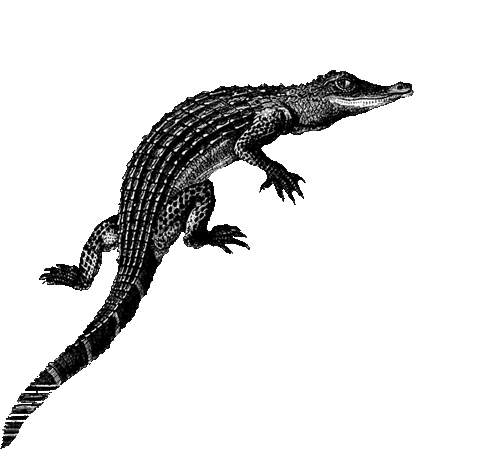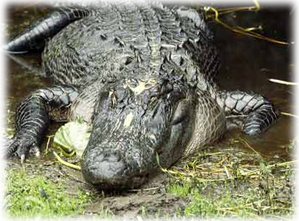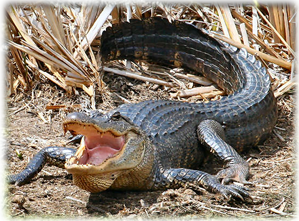
Description
American Alligator The American Alligator has a large, slightly rounded body, with thick limbs, a broad head, and a very powerful tail. They generally have an olive, brown, gray or nearly black color with a creamy white underside. American Alligator allegedly reached a length of 19 feet 2 inches, which would have made it the largest ever recorded, but this has never been verified or even supported by reliable information and is considered highly unlikely by experts. The tail, which accounts for half of the alligator's total length, is primarily used for aquatic propulsion. The tail can also be used as a weapon of defense when an alligator feels threatened. Alligators travel very quickly in water and while they are generally slow-moving on land, alligators can lunge short distances very quickly. They have five claws on each front foot and four on each rear foot. American Alligators have the strongest bite of any living animal, measured at up to 9,452 newtons in laboratory conditions. Some alligators are missing an inhibited gene for melanin, which makes them albino. These alligators are extremely rare and practically impossible to find in the wild. They could survive only in captivity. Like all albino animals, they are very vulnerable to the sun and predators.
Habitat
American alligators are mostly found in the Southeastern United States. Virginia/North Carolina south to Everglades National Park in Florida and Texas. They are also found in North Carolina, South Carolina, Georgia, Florida, Louisiana, Alabama, Mississippi, Arkansas, Texas, Virginia and Oklahoma. Florida and Louisiana currently have the largest population of alligators. Although primarily freshwater animals, alligators will occasionally venture into brackish water. Alligators live in wetlands and this is the vital habitat that holds the key to their continued long-term survival. Alligators depend on the wetlands, and in some ways the wetlands depend on them. American alligators are less susceptible to cold than American Crocodiles. Unlike the American Crocodile which would quickly succumb and drown in water of 45 °F, an alligator can survive in such temperatures for some time without apparent discomfort.
Diet
Alligators eat fish, birds, turtles, snakes, mammals, and amphibians. Hatchlings are restricted to smaller prey items like invertebrates. Insects and larvae, snails, spiders, and worms make-up a big portion of a hatchling's diet. They will also eat small fish at any opportunity. As they grow, they gradually move onto larger fish, mollusks, frogs and small mammals like rats, and mice. Some adult alligators take a larger variety of prey ranging from a snake or turtle to a bird and moderate sized mammals like a raccoon or deer.
Once an alligator reaches adulthood, any animal living in the water or coming to the water to drink is potential prey. Adult alligators will eat razorbacks, deer, domestic animals including cattle and sheep, and are often known to kill and eat smaller alligators. In rare instances, large male alligators have been known to take down a Florida panther and an American Black Bear, making the American alligator the apex predator throughout its distribution.








